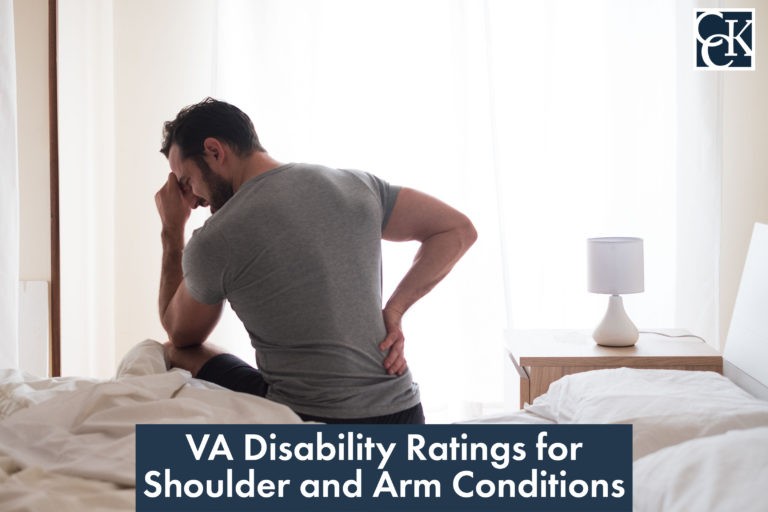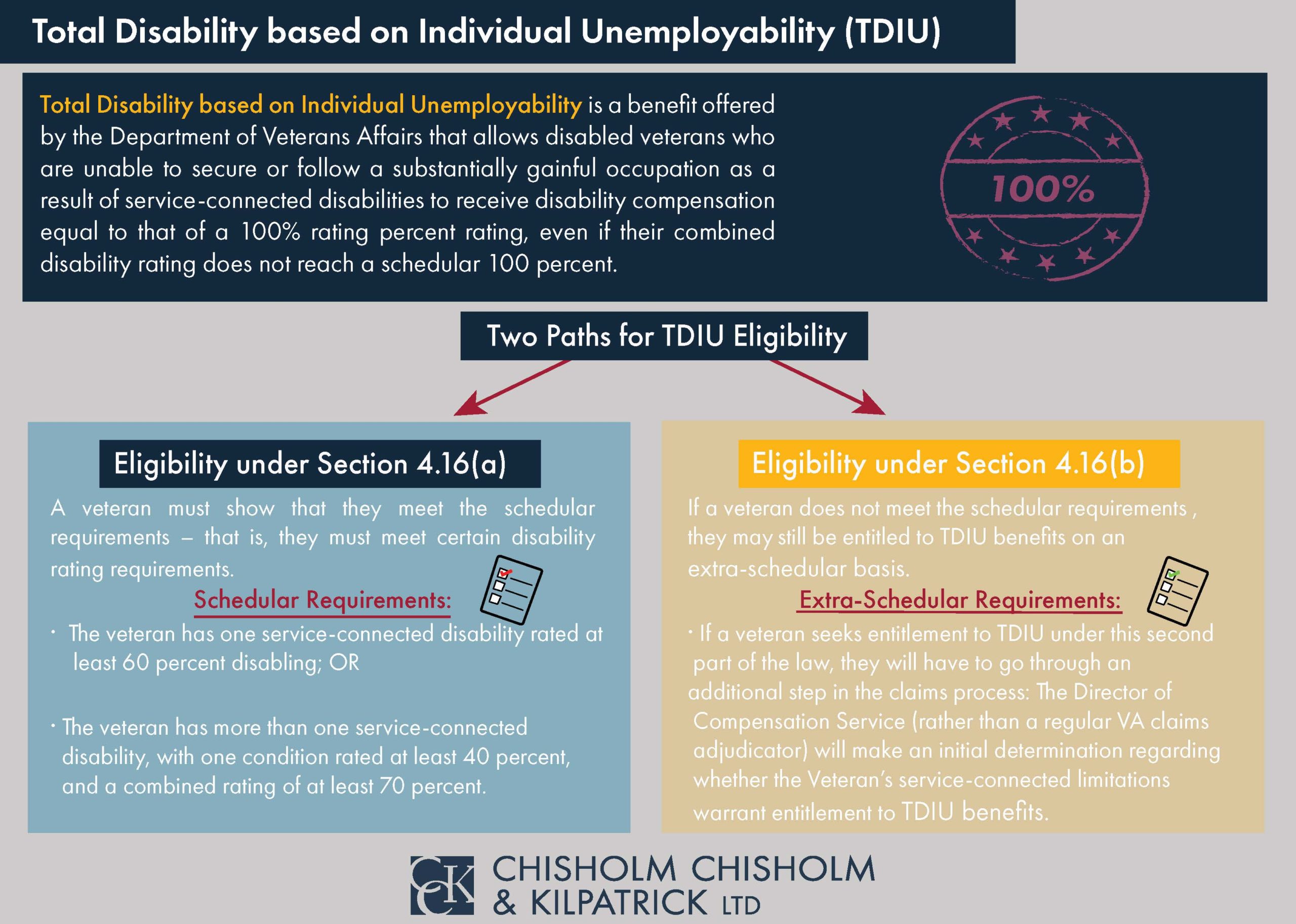VA Disability Ratings for Shoulder and Arm Conditions

CCK Law: Our Vital Role in Veterans Law
Injuries to the shoulder and arm commonly occur while performing both combat and non-combat duties during service. However, establishing service connection for shoulder and arm conditions can be difficult. Veterans must (1) have a current, diagnosed shoulder or arm condition; (2) have experienced an event, injury, or illness during service; and (3) provide a medical nexus linking their shoulder or arm condition to their in-service event. Once service connection is granted, VA will assign a disability rating based on the severity of the veteran’s condition.
Common Shoulder and Arm Conditions Among Veterans
Many activities in service, such as lifting heavy objects, transporting heavy supplies, or forms of physical training, can often cause shoulder and arm injuries. Injuries in combat, such as a blow from an accident, a forceful impact, or a fall, could also result in shoulder or arm injury. Below are some common examples of shoulder and arm conditions:
- Shoulder Dislocation – A dislocated shoulder occurs when the upper arm bone pops out of the socket in the shoulder blade. It can cause swelling, bruising, pain, or the inability to move the shoulder or arm. The shoulder may appear visibly dislocated as well.
- Shoulder Separation – A shoulder can become separated when the ligaments that attach the collarbone, or clavicle, to the shoulder become stretched or torn. In some cases, a separated shoulder requires surgery to repair. Symptoms include pain, weakness, bruising, swelling, and limited movement.
- Rotator Cuff Tear – The rotator cuff is the collection of muscles and tendons surrounding the shoulder joint. The rotator cuff is responsible for keeping the head of the upper arm bone in the shoulder socket. Usually, a single injury can cause a rotator cuff tear and extensive tears may not be repairable. With a rotator cuff injury, symptoms may include weakness, pain, and trouble moving the arm or lifting things.
- Shoulder Tendonitis – Shoulder tendonitis occurs when the rotator cuff and the biceps tendon become inflamed. The inflammation can be mild to severe. Symptoms include pain and limited mobility.
- Shoulder Bursitis – Like shoulder tendonitis, shoulder bursitis is caused by inflammation. The subacromial bursa lies between the rotator cuff and shoulder blade and protects the tendons in this area. When the bursa becomes inflamed, it can cause pain and stiffness in the shoulder.
- Shoulder Replacement – A shoulder may need to be replaced to reduce pain and increase mobility, strength, and function. Typically, a shoulder may need to be replaced as the result of severe arthritis or a serious shoulder fracture. During replacement surgery, parts of the shoulder joint are replaced with artificial implants.
- Shoulder Amputation—As the result of injury, the arm or shoulder may need to be amputated. The VA has specific rating codes if a shoulder or arm need to be amputated.
How VA Rates Shoulder and Arm Conditions
Generally speaking, VA rates shoulder and arm conditions under both 38 CFR § 4.71a – Schedule of Ratings – Musculoskeletal System and § 4.73, Schedule of Ratings – Muscle Injuries. The following Diagnostic Codes are included under the former and evaluated based on the range of motion of a major/minor joint group:
Diagnostic Code 5200 – Scapulohumeral articulation, ankylosis (abnormal stiffening and immobility) of:
- 50% (major)/40% (minor) – unfavorable, abduction limited to 25 degrees from side
- 40/30% – intermediate between favorable and unfavorable
- 30/20% – favorable, abduction to 60 degrees, can reach mouth and head
Diagnostic Code 5201 – Arm, limitation of motion of:
- 40/30% – to 25 degrees from side
- 30/20% – midway between side and shoulder level
- 20/20% – at shoulder level
Diagnostic Code 5202 – Humerus, other impairment of:
- 80/70% – loss of head of (flail shoulder)
- 60/50% – nonunion of (false flail joint)
- 50/40% – fibrous union of
- Recurrent dislocation of scapulohumeral joint
- 30/20% – with frequent episodes of guarding of all arm movements
- 20/20% – with infrequent episodes, and guarding of movement only at shoulder level
- Malunion of
- 30/20% – marked deformity
- 20/20% – moderate deformity
Diagnostic Code 5203 – Clavicle or scapula, impairment of:
- 20/20% – dislocation of
- Nonunion of
- 20/20% – with loose movement
- 10/10% – without loose movement
- 10/10% – malunion of
The Diagnostic Codes under 38 CFR § 4.73 for shoulder and arm conditions are split into six groups based on the limitation of motion of the different affected muscles. All of the criteria include severe, moderately severe, moderate, or slight and corresponds to a disability rating ranging from 0 to 40 percent. The disability rating assigned also depends on whether the veteran’s dominant (higher evaluation) versus nondominant (lower evaluation) arm is affected.

Compensation and Pension Exams (C&P) for Shoulder and Arm Conditions
VA may request a Compensation and Pension (C&P) exam to examine the veteran’s shoulder or arm condition. In the exam, either a VA physician or VA contracted physician will generally ask questions about the shoulder or arm condition and the veteran’s time in service. The examiner may also perform a physical exam on the veteran.
Often shoulder and arm conditions are rated based on range of motion. To obtain an official measurement of range of motion, the examiner will typically use a tool called a goniometer.
After the exam, the examiner will use the findings to issue an opinion, which will either be favorable or unfavorable. A favorable opinion will endorse the view that the shoulder or arm condition was caused by service. An unfavorable opinion will not.
Veterans should be sure to attend a Compensation and Pension exam once it has been scheduled, as failure to attend can stand as the basis for a denial of the veteran’s claim. Additionally, after the exam, veterans should be sure to request that a copy of the examiner’s report be sent to them. VA does not send copies of the report unless specifically requested, so in order to receive a copy, the veteran must request one.
Amputations Resulting from Shoulder and Arm Conditions
If a veteran’s shoulder or arm condition results in an amputation, then it will be rated differently. Specifically, if the entire arm is amputated from the shoulder joint down, including the scapula, clavicle, and/or ribs, it is rated 100 percent regardless of whether it is the dominant or non-dominant arm (Diagnostic Code 5120).
If the amputation involves the complete removal of the humerus only, it is rated at 90 percent.
If the arm is amputated below the shoulder but above the point where the deltoid attaches to it, then it is rated 90 percent for the dominant arm, and 80 percent for the non-dominant arm (Diagnostic Code 5121).
Finally, if the amputation is below the deltoid but above the elbow, it is rated 80 percent for the dominant arm and 70 percent for the non-dominant arm (Diagnostic Code 5122).
VA Ratings for Shoulder Replacements
Shoulder replacements are evaluated under Diagnostic Code 5051. If the entire shoulder joint has been replaced by a prosthetic device, the condition is rated at 100 percent for one month after being discharged from the hospital following the replacement. After the one-year period, the condition is then given a permanent rating.
Specifically, if there is weakness and severe pain with motion, then it is rated 60 percent for the dominant arm and 50 percent for the non-dominant arm. If there are occasional periods of weakness, pain, or limited motion then the condition should be rated analogously either under Diagnostic Code 5002 (i.e., rheumatoid arthritis) or 5203 (i.e., impairment of the clavicle or scapula), whichever most closely describes the veteran’s symptoms.
The final diagnostic code for this rating will either look like 5051-5002 or 5051-5203, where the first four-digit code defines the condition as a shoulder replacement, and the second code tells how the condition is rated. Importantly, the minimum rating for any total shoulder replacement is 30 percent for the dominant arm and 20 percent for the non-dominant arm.
VA Disability Compensation for Shoulder Surgery
Temporary Total Rating Following Surgery
Veterans who undergo shoulder surgery may be eligible for a temporary total rating based on convalescence. Specifically, veterans will be assigned a 100 percent rating until intensive treatment is over. Once it ends, the 100 percent rating will continue for a period of 3 months (unless otherwise specified).
Separate Ratings vs. Pyramiding
Separate ratings occur when there is another distinct manifestation of a disability that is not currently rated. For example, a veteran can be entitled to multiple disability ratings for a knee condition if they experience instability in addition to limitation of motion. In contrast, pyramiding is a practice prohibited by VA, and refers to when a veteran has two disability ratings for a single manifestation of their disability. Veterans can only be compensated once for each manifestation of a disability. For example, a veteran cannot receive two disability ratings to compensate them for their back pain caused by a single condition.14:05
Obtaining TDIU with a Shoulder or Arm Condition
If the veteran is unable to obtain substantially gainful employment as the result of a shoulder or arm condition, they may be eligible for total disability based on individual unemployability (TDIU). Veterans who are granted TDIU are paid at the one hundred percent rate, which is the highest form of compensation VA awards.
About the Author
Share this Post

